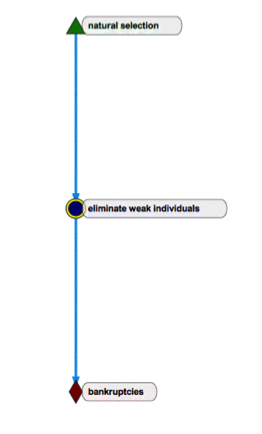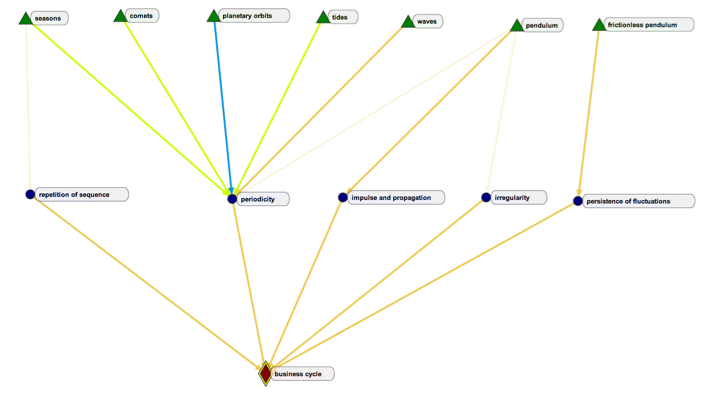Exploring metaphorical usage in economics — A research project
In the midst of the business depression of 1882–85 and a few months after the panic of May 1884 in the U.S., an article in the Omaha Daily Bee felicitated on “getting along splendidly with our failures, our curtailments of production, our reductions of wages, and other economies” as this would eventually prepare the country “to start anew with a good foundation to work on”. It thus wished
The article gives no reason why bankruptcies should prepare a solid ground for business. Resorting to the image of natural selection, forcefully reinforced with an example of man-made selection, the author refers the reader (but possibly also himself) to a process the operation of which is better understood (the abstract concept of ‘natural selection’ is even further exemplified by the reference to the kitten). The metaphor is meant to transfer a property of natural selection (the source), namely, the elimination of weak individuals and the survival of the strongest, to the target of the metaphor, the bankruptcies.that the process of natural selection through bankruptcy shall go on till the weak concerns are all weeded out. The feeble and unpromising kitten of the litter should be decently drowned and the strong ones left to thrive. (Anonymous, The business situation, Omaha daily bee, December 25, 1884, p. [7])
 according to the general scheme:
according to the general scheme: 
This example comes from a newspaper. The usage of images from outside the disciplinary source, however, is not limited to popular writings. We find it almost universally in the economic literature (and surely also in other disciplines): in journal articles, textbooks and treatises; in the work of the pioneers as well as in the most recent literature; there are numerous examples in all languages; they are used as metaphors, as analogies, as similes or as metonymies; they and they are applied with different purposes —as an illustration, as analytical expedients, as substitutes for proper explanations, as an aid to communication, with methodological or epistemic relevance, or with a heuristic function.
Metaphors (let us, for the sake of brevity, use this term to encompass all forms of transfers from one domain to another via figures of speech) form a rather tangled web. First, each source has several properties, which are often transferred selectively. Comets, for instance, have been evoked in connection with crises for their periodicity and for the predictability of their return, but have also been compared to panics for the surprise and alarm they caused among simple people up to the middle ages. The following diagram illustrates these relationships.

(in this graph, and in those to follow, each arrow connecting sources, properties transferred and targets correspond to historical examples).
The existence of multiple properties that can be transferred from source to target is precisely what makes metaphorical transfers and analogical reasoning both so powerful and so dangerous at once. On the one hand, metaphors are suggestive: when an author writes that “crises are the tempests of the business world”, s/he has in mind one or a number properties of tempests that are suitable to characterize crises (in this example, such a property is not made explicit). This is suggestive, because it enables readers to imagine in turn other properties of ‘tempests’ that may be fruitfully transferred to crises. Historically, this actually occurred: in the 1830s, storms were evoked for their universally destructive power; a few decades later, they were seen as selectively destructive, affecting only weak or corrupted businesses and thus clearing the ground for a more solid economy; another few years later, and storms were also seen to be irrigating the soil and thus facilitating the sprouting of new vegetation/businesses. The same source was thus used to transfer rather different properties to the target, actually giving rise (or at any rate reflecting) different theories of crises. On the other hand, analogical reasonings are intrinsically dangerous, as they may induce to transfer from the source properties that are not pertinent to the target.
Second, often the properties one wants to transfer do not characterize only one specific metaphorical source, but several. For instance, ‘periodicity’ (a property of crises, cycles and panics) has been represented by means of several images besides the periodical comets: the pendulum, the recurring of reasons, planetary orbits, the tides and waves

Third, targets also have many properties that can be represented or illustrated by means of metaphorical transfer. ‘Business cycles’, for instance, inherits the properties of being periodical, being characterized by repetition of sequence, being subject to impulses that are transmitted and propagated throughout the economic system, of being irregular in its course but presenting persistent fluctuations. These properties, in turn, are transferred from different sources, as summarized in the illustration below:

Given this pyramidal and intersecting structure of the triplets source-property-target, it is easy to understand that different (related, but possibly antithetic) targets can be indirectly linked via some metaphor interpreted, or set to work, in different ways. As an example, consider